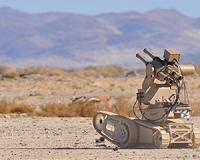| . |  |
. |
Naval Air Station Patuxent River MD (SPX) Mar 22, 2010 A supersonic Lockheed Martin F-35B Lightning II stealth fighter rode more than 41,000 pounds of thrust to a vertical landing for the first time, confirming its required ability to land in confined areas both ashore and afloat. "The vertical landing onto a 95-foot square pad showed that we have the thrust and the control to maneuver accurately both in free air and in the descent through ground effect," said F-35 Lead STOVL Pilot Graham Tomlinson. Tomlinson performed an 80-knot (93 miles per hour) short takeoff from Naval Air Station Patuxent River, Md., at 1:09 p.m. EDT. About 13 minutes into the flight, he positioned the aircraft 150 feet above the airfield, where he commanded the F-35 to hover for approximately one minute then descend to the runway. "The low workload in the cockpit contrasted sharply with legacy short takeoff/vertical landing (STOVL) platforms," said Tomlinson, a retired Royal Air Force fighter pilot and a BAE Systems employee since 1986. "Together with the work already completed for slow-speed handling and landings, this provides a robust platform to expand the fleet's STOVL capabilities." Robert J. Stevens, Lockheed Martin chairman and chief executive officer, said, "The vertical landing of the F-35 BF-1 aircraft was a vivid demonstration of innovative technology that will serve the global security needs of the U.S. and its allies for decades to come. I am extremely proud of the F-35 team for their dedication, service and performance in achieving this major milestone for the program." Doug Pearson, Lockheed Martin vice president of F-35 Test and Verification, said, "The successful first vertical landing met our test objectives and demonstrates the F-35B's capacity to operate from a very small area at sea or on shore - a unique capability for a supersonic, stealth fighter. This is the first of many such tests to fully define the short takeoff and vertical landing (STOVL) characteristics of the world's most capable 5th generation fighter. We will routinely conduct vertical landings and short takeoffs to further expand the operational flight envelope for the F-35B." The aircraft in the test, known as BF-1, is one of three F-35B STOVL jets currently undergoing flight trials at the Patuxent River test site. It is powered by a single Pratt and Whitney F135 turbofan engine driving a counter-rotating Rolls-Royce LiftFan(r). The shaft-driven LiftFan system, which includes a Rolls-Royce three-bearing swivel duct that vectors engine thrust and under-wing roll ducts that provide lateral stability, produces more than 41,000 pounds of vertical lift. The F135 is the most powerful engine ever flown in a fighter aircraft. The F-35B will replace U.S. Marine Corps AV-8B STOVL fighters and F/A-18 strike fighters. The United Kingdom's Royal Air Force and Royal Navy, and the Italian Air Force and Navy will employ the F-35B as well. With its short takeoff and vertical landing capability, the F-35B will enable allied forces to conduct operations from small ships and unprepared fields, enabling expeditionary operations around the globe. The F-35 program is using the Lockheed Martin-developed Autonomic Logistics Information System (ALIS) for maintenance actions, spares tracking and technical data support.ALIS is part of the F-35's innovative sustainment architecture monitored by the F-35 Autonomic Logistics Global Sustainment (ALGS) Operations Center in Fort Worth. The early deploymentof the F-35 net-enabled logistics system to be used by all nine partner countries helps ensure the F-35'ssmooth transition to operational status, and is a key enabler for lower life cycle costs. The F-35 Lightning II is a 5th generation fighter, combining advanced stealth with fighter speed and agility, fully fused sensor information, network-enabled operations, advanced sustainment, and lower operational and support costs. Lockheed Martin is developing the F-35 with its principal industrial partners, Northrop Grumman and BAE Systems. Two separate, interchangeable F-35 engines are under development: the Pratt and Whitney F135 and the GE Rolls-Royce Fighter Engine Team F136.
Share This Article With Planet Earth
Related Links Lockheed Martin The latest in Military Technology for the 21st century at SpaceWar.com
 Metal Storm Packs A Punch In UGV Live-Fire
Metal Storm Packs A Punch In UGV Live-FireBrisbane, Australia (SPX) Mar 19, 2010 Metal Storm has received video footage from the US Navy of Metal Storm weapon systems taking part in an unmanned systems-based live-fire demonstration. This footage is now being made available on the Metal Storm website. China Lake, located on the edge of California's Mojave Desert, was chosen to provide a realistic environment for the demonstrations. With temperatures reaching 110 degrees ... read more |
|
| The content herein, unless otherwise known to be public domain, are Copyright 1995-2010 - SpaceDaily. AFP and UPI Wire Stories are copyright Agence France-Presse and United Press International. ESA Portal Reports are copyright European Space Agency. All NASA sourced material is public domain. Additional copyrights may apply in whole or part to other bona fide parties. Advertising does not imply endorsement,agreement or approval of any opinions, statements or information provided by SpaceDaily on any Web page published or hosted by SpaceDaily. Privacy Statement |